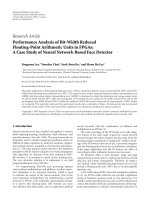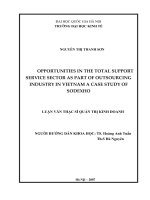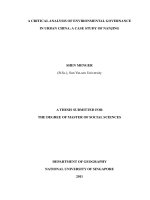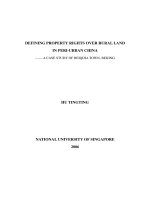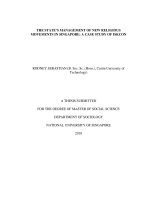Newspaper commercialization and its political implications in china a case study of yangtse evening post
Bạn đang xem bản rút gọn của tài liệu. Xem và tải ngay bản đầy đủ của tài liệu tại đây (648.06 KB, 140 trang )
NEWSPAPER COMMERCIALIZATION AND ITS POLITICAL
IMPLICATIONS IN CHINA:
A CASE STUDY OF THE YANGTSE EVENING POST
WANG YI
NATIONAL UNIVERSITY OF SINGAPORE
2005
NEWSPAPER COMMERCIALIZATION AND ITS POLITICAL
IMPLICATIONS IN CHINA:
A CASE STUDY OF THE YANGTSE EVENING POST
WANG YI
(B.A. (Hons.). Nanjing University)
A THESIS SUBMITTED
FOR THE DEGREE OF MASTER OF ARTS
COMMUNICATIONS AND NEW MEDIA PROGRAMME
NATIONAL UNIVERSITY OF SINGAPORE
2005
i
ACKNOWLEDGEMENTS
Researching and writing this thesis has been an amazing journey, but it would not
have been possible without the help of a lot of people. First of all, I want to thank
my supervisor Dr. Doobo Shim, who guided my graduate studies at CNM with
unfailing inspiration and supervised the thesis with great expertise and care. I am
extremely grateful to A/P Milagros Rivera and other professors of CNM who have
always been insightful and supportive. I would also like to acknowledge my thanks
to the Faculty of Arts and Social Sciences, National University of Singapore, for
providing financial support for the fieldwork in Nanjing.
I want to express my appreciation to all my interviewees for their
commitment to supporting this research. I am also very thankful to Miss Stewart,
my proofreader, for her great patience and invaluable help.
Particular thanks go to my fellow graduate students at CNM. Shen Cuihua,
Jiang Wei and Huang Shansi have provided me with, not only inspiring ideas, but
also beautiful memories.
To my parents and my husband, I owe the greatest debt. I particularly thank
them for their confidence in me and for all their efforts in making my family the
best harbor for me.
ii
TABLE OF CONTENTS
CHAPTER 1 INTRODUCTION AND RESEARCH QUESTIONS .....................................1
1.1 Choice of Theoretical Framework..................................................................................2
1.2 Research Questions ........................................................................................................4
1.3 Approaches of the Study ................................................................................................6
1.4 Thesis Structure..............................................................................................................7
CHAPTER 2 LITERATURE REVIEW ................................................................................10
2.1 Media and Public Sphere..............................................................................................10
2.1.1. The Theory of the Public Sphere......................................................................10
2.1.2 Critique of the Public Sphere ............................................................................13
2.1.3. Media and Public Sphere..................................................................................14
2.2 Public Sphere in the Context of China .........................................................................15
2.3 Media Commercialization: the Death of Public Sphere? .............................................18
2.4. Conclusion ..................................................................................................................23
CHAPTER 3 NEWSPAPER COMMERCIALIZATION IN CHINA: CONTINUITY AND
CHANGE ..................................................................................................................................25
3.1 The Newspaper Commercialization in China...............................................................25
3.1.1 Background Parameters.....................................................................................25
3.1.2 Stages of Newspaper Commercialization in China ...........................................30
3.1.3 Advertising in Newspaper Commercialization..................................................40
3.1.4 Problems of Newspaper Commercialization in China ......................................46
3.2 China’s Media Commercialization: a Struggling Way to Public Sphere? ....................50
3.3 Previous Empirical Research .......................................................................................54
CHAPTER 4 METHODOLOGY ...........................................................................................57
4.1 The Case of the YEP ....................................................................................................57
4.1.1 The Method of Case Study................................................................................57
4.1.2 The Selection of the YEP ..................................................................................58
4.2 The General Perspective of the Research.....................................................................61
4.3 Content Analysis Method .............................................................................................63
4.3.1 The Procedures of Data Collection....................................................................63
4.3.2 Data Analysis and Coding Frame......................................................................64
4.3.3 Reliability and Validity......................................................................................65
4.4 In-depth Interview Method...........................................................................................67
4.4.1 Selection of Interviewees ..................................................................................67
4.4.2 Semi-structured Interview Topic Guide ............................................................69
4.4.3 Procedures of the Interviews and Data Analysis ...............................................70
CHAPTER 5 CONTENT ANALYSIS RESULTS AND DISCUSSIONS ............................72
5.1 The Amount of Advertisement .....................................................................................72
5.2 The Content of Advertisement .....................................................................................73
5.3 The Layout of Advertisement.......................................................................................77
iii
5.3.1 Color Difference................................................................................................77
5.3.2 Dimensions of Advertisement ...........................................................................77
5.3.3 Location of Advertisement ................................................................................79
5.3.4 The Infomercials ...............................................................................................83
5.4 Conclusion ...................................................................................................................86
CHAPTER 6 INTERVIEW FINDINGS AND DISCUSSIONS ...........................................88
6.1 Increasing Income and Favor of Advertising ...............................................................88
6.2 Caution of the Market Competition .............................................................................93
6.3 Frustration by Government Censorship .......................................................................98
6.4 Divergent Perceptions about Press Freedom..............................................................101
6.4.1. The Generation Gap .......................................................................................101
6.4.2. The Geographic Gap ......................................................................................103
6.5 Ambiguity about the Practical Role of the YEP .........................................................104
6.6 The Threats of Commercialization.............................................................................108
6.7 Conclusion .................................................................................................................111
CHAPTER 7 CONCLUSION ............................................................................................... 113
7.1 Summary of Findings.................................................................................................113
7.2 Overall Conclusions ...................................................................................................114
7.3 Limitations and Suggestion for Future Research .......................................................117
BIBLIOGRAPHY ..................................................................................................................120
APPENDIX 1..........................................................................................................................127
APPENDIX 2..........................................................................................................................129
APPENDIX 3..........................................................................................................................130
iv
SUMMARY
In the transformation of China’s media from the conventional propaganda machine
to the profit makers in recent decades, a number of commercial newspapers have
emerged. Long under control, Chinese media’s financial independence, which has
been gained through commercialization, is argued to be healthy for the media to
realize their civic role and to further promote the country’s democratization.
Against this backdrop, this empirical research aims at exploring the political
implications of the newspaper commercialization. The Habermasian public sphere
and his concern about media’s “refeudalization” are used as the theoretical
framework. After a holistic examination of the development of newspaper
commercialization in China, the researcher selected the Yangtse Evening Post
(YEP), the most circulated commercial newspaper in China, for a case study. The
content analysis of its advertisement has mapped the extent to which the YEP has
been commercialized and the semi-structured interviews of 15 reporters and editors
have explored the political implications of the newspaper commercialization with
such a fusion of the Party and the market. It is found that the YEP is gingerly
juggling itself between the Party and the market. It is concluded that, rather than
fulfilling the civic role of the public sphere, China’s commercial newspapers are
facing the problem of “double feudalization”.
ii
LIST OF TABLES
Table 4.1. List of Interviewees ...................................................................... 69
Table 5.1. Frequencies of advertisement contents in 1995 ............................. 73
Table 5.2. Frequencies of advertisement contents in 2004 ............................. 74
Table 5.3. Dimension of advertisement in 1995............................................. 78
Table 5.4. Dimension of advertisement in 2004............................................. 78
Table 5.5. Locations of advertisement in 1995 .............................................. 79
Table 5.6. Locations of advertisement in 2004 .............................................. 79
Table 5.7. Content * Front page * Dimension Crosstabulation in 1995.......... 81
Table 5.8. Content * Front page * Dimension Crosstabulation in 2004.......... 82
Table 5.9. Proportion of soft advertisement and conventional advertisement . 83
Table 5.10. Content * advertisement type Crosstabulation of advertisement in
2004...................................................................................................... 84
Table 5.11. Soft ads * dimension * location Crosstabulation ......................... 85
iii
LIST OF FIGURES
Figure 3.1. The Structure of media system in China ...................................... 26
Figure 3.2. Advertising Revenues of the Newspapers in China, 1983-2004 ... 41
Figure 3.3. Number of newspapers in China, 1978-2003 ............................... 43
Figure 3.4. Proportion of Party paper and commercial paper, 1986-1996....... 44
1
CHAPTER 1 INTRODUCTION AND RESEARCH QUESTIONS
In the post-Cold War era and the globalization age, the arena of the media is no
longer considered solely as an ideological machine. Instead, liberalization – “a
process of state intervention to expand the numbers of participants in the market”
(Mosco, 1996, p. 203) – has been widely embraced and consequently,
commercialization followed that “business practices” (p.203) and “greater
emphasis on market position and profitability” (p.202) have become the main
themes of the media’s agenda.
As the process of media commercialization applies to “both public and
private sector organizations” (Mosco 1996), the transforming public space and
interest of communication has thus been viewed with concern by various western
critics. Their main concern, however, is the fast shrinking Habermasian public
sphere (Habermas, 1974) as independent as media commercialization is growing
(for instances, Habermas 1989; Dahlgren 2000). In the process of
commercialization, media outputs are commodified and are designed to serve
market needs, rather than the needs of citizens (Herman and McChensney 1998). In
the light of this, democratic media reformers have even suggested a “maximum
feasible de-commodification and ‘re-embedding’ of communications media in the
social life of civil society as vital for freedom from state and market censorship”
(Keane, 1991, p. 153).
2
These researchers who bemoan the decline of the above mentioned public
sphere are specifically addressed in the western context. However, the situations
might significantly differ in various contexts and at different stages of media
commercialization. In this study, the researcher shall examine newspaper
commercialization in China, arguably the most authoritarian country where media
have been commercialized since 1978 and at a relatively fresh stage compared to
western media.
1.1 Choice of Theoretical Framework
It is unanimously identified that China’s media are not fully independent from the
government. Instead, China’s media are believed to have “commercialization
without independence” or “bird-caged press freedom” (Lee 2000, p. 10; Chan,
1993). Nonetheless, researchers studying this field (for example, Lee 1990, 1994,
2000, 2003) still believe the market to be healthy for China’s media development,
especially in the political sense. They contend that marketization is gaining media
financial independence and will further help to attain political independence (Wang
2003). Because of this separation from the state, the media can be critical of the
China Communist Party (CCP, thereafter the Party) and positively imply the
country’s democratization.
The newspaper remains one of the most influential forms of the media in
China because of its overwhelming popularity, especially when compared to the
3
Internet. Because of its low penetration, the Internet in China still faces the biased
doubt to arguably become a democratic tool. On the contrary, the low price and
solid establishment as the oldest form of media has well defended the newspaper ’s
significance in China’s media scene.
In response to these previous studies and based on the observation of China’s
newspapers as mentioned, one should bear in mind relevant major factors when
discussing the political implications of China’s media commercialization: the
separation of the media from the Party and the accessibility and openness of the
media to the public. These dual factors, however, overlap two of the major
assumptions underlying the concept of “public sphere”.
The notion of the public sphere was conceptualized by the German
philosopher Habermas following the critical tradition of the Frankfurt School. His
original idea of public sphere, indeed, derived from the bourgeois classes of
Western Europe in the late 17th and 18th century when people gathered at public
places such as the café and talked about state matters concerning public interests.
In this space open to everyone, people freely delivered their opinions and through
their discourse, they fulfilled their citizenship. This sphere is conceptualized to
situate between the private sphere and the sphere of public authorities. Thus, its
primary task is to protect the private sphere from it being encroached upon by the
public authorities.
Although the Habermasian public sphere has been criticized for its
4
male-centered, idealized and historical limitations for its existence only under a
certain context, the concept of public sphere is still useful in understanding
democratic potential for communication processes (Calhoun 1992b; Dahlgren
1995). The “democratic potential” is especially important for China’s newspaper
commercialization at the current stage in this study. On the one hand, democracy is
yet to be realized in this country where authoritarianism has been fully ingrained in
its long history. In this context, one should be warned that the existence of public
sphere might not necessarily suggest the coming of democracy. On the other hand,
commercialization in China’s media is still young compared to its peers in western
countries. In the later stages, the roles it may play still remain unclear. Against this
backdrop, this study using the concept of public sphere to focus on the current
stage of newspaper commercialization in China may not only fill the sparsely
covered field, but also suggest the “democratic potential” in the largest population
of the world.
1.2 Research Questions
This study tries to explore the political implications of the newspaper
commercialization in China using the notion of public sphere. However, as the
public sphere is a relatively abstract theoretical framework, it is more constructive
for the research to firstly measure the extent of commercialization and contextually
delve into its political implications. Empirically, the case of the most circulated
5
commercial newspaper in China – the Nanjing-based Yangtse Evening Post
(“Yangzi Wan Bao”, thereafter the YEP) (IFABC, 2005) – is going to be studied.
The selection of the YEP is based on five main reasons. First, the biggest
circulation among China’s commercial newspapers has made the YEP a valid
representative of the country’s commercial newspapers. Secondly, the YEP is a
typical Chinese commercial newspaper. It was set up by the Party organ of the
province, the Xinhua Daily (“Xinhua Ri Bao”, thereafter XD), which is also the
administrative leader of the press group the YEP belongs to. As the XD is no longer
popular in the market and has little financial income and almost survives on
subsidies from the government and the press group, its deficit has been indirectly
filled by the YEP’s financial contribution to the press group. This situation is
widely shared by other commercial newspapers in China. Thirdly, the YEP is
located in the developed city of Nanjing where the interplay of politics and
economics is evident. In addition, Nanjing also has a reputation for its high
concentration of intellectuals, who are claimed to be the most active group in
China’s political discourse (Kluver, 1999). Fourth, because of the YEP’s
avant-garde status, its development may well reflect where Chinese commercial
newspapers are headed towards in the future. Finally, because the researcher is
from Nanjing and has some acquaintances from the YEP, the feasibility of the
fieldwork has been much enhanced.
By selecting the YEP as a case study, the researcher tries to explore the
6
following questions:
1.
Using advertising as an index, to what extent has the YEP been
commercialized since it was set up in 1986?
2.
In what ways do market forces and the Party control influence the news
production of a typical commercial newspaper?
3.
What are the political implications of such a fusion of Party control and
market forces in China’s newspaper commercialization?
1.3 Approaches of the Study
To answer the above research questions, this study has adopted a combination of
two primary methods: content analysis and in-depth interviews. Archive analysis is
also employed in the research to supplement the results. However, the results of
archive analysis are synthesized with the findings and discussions of content
analysis and interviews (i.e. Chapter 5 and Chapter 6) for the sake of coherency.
This method combination is named as methodological triangulation according
to Denzin (1978, p. 28). The two methods in this study counterbalance each other
as “the weaknesses in each single method will be compensated” (Jick 1979, p. 604)
as well as to confirm the data of each other. The content analysis is used in this
study to describe the characteristics of communication (Holsti 1969) while the
other method, the in-depth interview, aims at the fundamental data to help in the
understanding of the relations between social actors and their situation (Gaskell
7
2000). By using the latter, the researcher tries to overcome the disadvantage of the
content analysis which is weak at understanding the effect of the media (Wimmer
and Dominick 2000).
This combination of different methods is also used to complete the data
collection in this study. As content analysis is a research method for the “objective,
systematic, and quantitative description of the manifest content of communication”
(Berelson 1952), the result of content analysis may not be adequate enough to
explore the implications the advertisement has made to the society. The
combination of three methods, which are from quantitative and qualitative stances
respectively, can represent varieties of data to help the researcher fully understand
the complicated social interaction.
1.4 Thesis Structure
This thesis is composed of a total of seven chapters including this Chapter 1, the
introduction. Chapter 2 will start with an introduction of the original concept of the
public sphere. By rethinking the notion of the public sphere and its transformation
in the modern social context, basic structural elements of the public sphere will be
extracted. A literature review on how previous studies discuss the western media
commercialization and the public sphere will also be given in this chapter. Finally,
the following question is to be addressed: in this so-called authoritarian country,
8
much different from western society, can the theory of the public sphere be applied
to it and if so, to what extent?
In Chapter 3, the trajectory of newspaper commercialization in China shall be
examined to offer a background as well as a pointer to help understand the degree
of commercialization of China’s newspapers. A brief overview of the history of
newspaper commercialization from its beginning in 1978 until 2004 will be given.
It will also explain the major changes as to the consequent prevalence and
importance of advertising. In addition, the major problems in this process will also
be summarized to help further contextualize Chinese commercialization. Lastly,
previous empirical studies in this vein that have exemplary implications to this
study will be discussed.
Chapter 4 discusses the research methodology in this study. In addition to the
archive research, a combination of content analysis and qualitative interview serves
as the main method in this thesis. This chapter justifies the usage of them and
explains the procedures of the research.
Chapter 5 reports the findings of a comparative content analysis on the YEP’s
advertising in 1995 and 2004. By this, the extent to which the YEP has been
commercialized will be quantitatively surveyed.
Chapter 6 reports the interview findings and discusses the political
implications underlying such a fusion of market call and government control.
Chapter 7 summarizes the findings of the thesis. It is concluded that the YEP
9
is gingerly juggling itself between the market and the Party. In this process, rather
than its playing the promising role as a public sphere, it is found China’s newspaper
commercialization is facing the problem of “double feudalization” (Zhan, 2005).
Finally, the limitations of the study and suggestions for future research are
included.
10
CHAPTER 2 LITERATURE REVIEW
In this chapter, the literature about media commercialization and its political impact
will be reviewed. The theoretical framework of the public sphere borrowed from
Habermas (1974) will be used in this discussion. This whole chapter will address
this theory from two perspectives: (1) The theory of the public sphere. (2) The
discussion of the contribution of the public sphere to the study of western media
commercialization.
2.1 Media and Public Sphere
In the modern societies, the role of media has risen to such a significant height that
it is arguably related to the development and functioning of a nation’s democracy.
With this heated discussion having lasted over decades, many scholars have
contributed various thoughts regarding the political role of media. Among these
literatures, the theory of the public sphere was frequently used in different contexts
and different periods.
2.1.1. The Theory of the Public Sphere
It is Habermas who first argued the concept of the public sphere which originated
in ancient Greece. Several theorists have differently challenged us to consider what
consists of the “public” and have questioned the problems of the mass media.
11
However, the Habermasian (1974) public sphere is the most fruitful one and widely
accepted as a popular notion. For him, the public sphere is,
…a sphere which mediates between society and state, in which the public
organizes itself as the bearer of public opinion, accords with the principle of
the public sphere – that principle of public information which once had to be
fought for against the arcane policies of monarchies and which since that time
has made possible the democratic control of state activities. (p.50)
Habermas’ original idea of the public sphere, indeed, is an historical phenomenon
within a specific context. The public sphere, according to him, derived from the
bourgeois classes of the Western Europe in the late 17th and 18th century when
people gathered at public places, such as café, elite journals and other places, to
freely discuss public matters concerning public interests. Everyone has the access
to the rational discussion. To sum up, Habermasian public sphere refers to a totality
of information and communication spaces that people use to critically exchange
views and formulate opinions.
As Habermas underscored, this sphere situates between the private sphere and
the sphere of public authorities. Thus, its primary task is to protect the private
interests from its being encroached by the public authorities and in which political
participation is enacted through the medium of talk.
Four core elements underlying the bourgeois public sphere, through various
literature and discussion, can be extracted as follows:
12
First of all, the existence of the public space where the discussions take place
is crucial. In the bourgeois public sphere, it could be referred to the cafés or elite
journals, etc. However, in the modern societies, it is not feasible to allow more than
relatively small numbers of citizens to be physically gathering together, mass
media hence can be considered as the institutions of the public sphere.
Second, every citizen has the equal access to the public space. In other words,
the space is open and accessible to everyone without any bar to prevent any special
group from joining the discussions. In this sense, mass media in China such as
newspapers or televisions have the potentials to fulfill the role of the public sphere
because they are affordable and have highly penetrated into people’s life.
Third, the citizens are free to deliver their opinions within the public space.
The citizens, without concerns about their identities or status hierarchies, feel
emancipated to deliver their minds. Through its status separations from the state
authorities, thus the public sphere can be critical of the state in principle.
Four, the discourses in the public sphere should be limited to reflection about
the common good instead of personal interests. As mentioned before, not only does
the public sphere separate itself from the state, it distances from the private sphere
as well. Hence, the topics in the public sphere should be discussed for the sake of
the public rather than for that of particular individuals. Politics and other current
affairs can be considered proper topics while personal lives are not encouraged.
13
2.1.2 Critique of the Public Sphere
The theory of the public sphere has always aroused different criticisms as many
researchers tried to put it in different contexts in different periods. As Habermas
(1989) admitted, his explanation of the public sphere would be much different if it
were published after several decades and had considered the contemporary
situations. Indeed, his analysis needs to undergo some “critical interrogation and
reconstruction”(Fraser 1992) to be capable of theorizing the actually existing
democracy. Some relevant criticisms can be summarized as follows.
First, Habermas was criticized for idealizing the bourgeois public sphere.
Historical studies have proved the intellectuals’ discussion did not control the print
market but rather the booty capitalism was more powerful. For instance, Robert
Darton (1982) has revealed the competitive structure of the early print market was
actually controlled by quick search of profit rather than rational discussions.
Second, Habermas was blamed as he failed to develop a new, post-bourgeois
model of the public sphere. His bourgeois conception of the public sphere was
premised on a social order in which the state was sharply differentiated from the
situations nowadays. He was further criticized because he never explicitly
questioned some dubious assumptions underlying the bourgeois model and his
followers are thus left without any idea of a sufficiently distinct conception from
the bourgeois public sphere to serve the need of contemporary study (Fraser 1992).
Third, critics also pointed out Habermasian model, developed as the norm for
14
the public discourses, neglected all other forms of communicative action not
directed toward consensus, thus Habermas was ruling out “both the rhetorical and
playful aspects of communicative action” (Garnham 1992, p. 360). This leads to
the distinction between information and entertainment mechanically made too
sharp. The critics especially emphasized this point because they felt it was worthy
of special notice in the context of contemporary democracies.
All these suggestions have pointed out how Habermas could improve his
theory of the public sphere. However, although the theory was with various
problems, it is still found useful and helpful. These problems could not undermine
the theory as a fruitful starting place to set out for exploration of the mass media
and democratic politics (Garnham, 1992). In this sense, the public sphere is very
crucial in our critical study of the media even nowadays.
2.1.3. Media and Public Sphere
In his discussion of the public sphere, Habermas suggested newspapers, periodicals,
radio and television as examples of the public sphere, where public opinions can be
formed through rational and dialogic process.
Other contemporary researchers have echoed his thoughts. For example,
Dahlgren (2000) argued that the mass media today have made current affairs
throughout the world available to most citizens, becoming the key source of
information as well as the forum of discussion among citizens. Abercrombie (1991)
15
further proposed that mass media are essential parts of the opening democracy.
Citing the conclusion of Curran (1991), Abercrombie suggested that we could view
the mass media as a standardized neutral area – the public sphere.
However, one needs to bear in mind is that the fact the mass media as the
public sphere is much different from the bourgeois public sphere especially in
terms of the communication mode. In the ideal bourgeois public sphere, the rational
discussion is guaranteed by a face-to-face communication while in the era of mass
media, the messages were represented through the media. This mediation of
message has raised two distinct problems according to Garnham (1992): unequal
accessibility to the media and the mediated experience of the lifeworld.
Against this backdrop, to discuss the contemporary media commercialization
using the framework of the public sphere in this research has one caveat. The term
of the public sphere is used in this study as an ideal model to describe the political
function of the media. The public sphere is a utopian ideal that is even not realized
among bourgeois in 17th and 18th century. Used as the framework to explore the
media’s political role, the concept of the public sphere is cast as a sociological
concept as well as an inspirational vision of something better yet to be attained
(Dahlgren, 1995).
2.2 Public Sphere in the Context of China
To use “the public sphere” as a theoretical framework for analysis outside the West
16
has become a trend. According to Rowe (1990), two reasons could explain this
trend: (1) The importance of this notion was gradually recognized by different
social researchers as it is powerful to explain kinds of emerging problems of the
society; (2) The idea of the public sphere has become “a critical element in any
attempt to identify what is distinctive about our contemporary world” (p. 309).
Under this trend, historians and other researchers of China, unexceptionally, have
also tried to relate this theory to their questions in specific cultural contexts.
Inevitably, the question about the appropriateness of putting the
western-originated term into China’s context has aroused constant debates. The
uniqueness of the public sphere, especially the ideal bourgeois public sphere, has
been argued by Habermas as “a category that is typical of an epoch” (Habermas,
1989, p. xvii). He stressed the historical context as the period when ‘civil society’
originated in the European High Middles ages and warned the problems might be
caused by the transfer to other historical situations. Furthermore, it turns more
complicated when the context is of China. As White, Howell and Shang (1996, p.2)
put it, any research, which seeks to investigate whether or to what extent this public
sphere is emerging in contemporary China, is bedeviled both by ambiguities of the
term itself and the complexity of the historical processes.
The usage of the public sphere in China, according to the historical account by
Xu (2001), was once purposely misrepresented by the Chinese New Left to arouse
a political debate. Habermas visited China in the spring of 2001. Initially he was
17
reluctant to visit because some members of the Chinese New Left, in their zeal to
construct anti-imperialist discourses, have (mis)used his theory in such a way that
amounts to justifying nationalist and authoritarian orientations of the Chinese state.
Emphasizing the universal applicability of human rights values, Habermas argued
that for the non-West to accept them did not necessarily mean its surrender to the
West, nor should they be seen as metaphysical concepts.
Stemmed from academic purpose, some researchers have traced back and tried
to prove the existence of some sparkles of the public sphere in late imperial China
(Chang 1971). With the availability of the Thomas Berger’s translation of
Habermas’s German work The Structural Transformation of Public Sphere into
English in 1989, a series of papers were aroused to discuss to what extent the
theory of the public sphere can be adopted within the context of China. Modern
China, the American-based academic journal focusing on the study of China,
devoted its 20th issues (i.e. April 1993) to this debate with a collection of several
significant figures’ works in this field. Among them, Huang (1993, p. 216) argued
that instead of adhering to the dichotomous opposition between state and society in
the original concept of the “public sphere” and “civil society”, we need to employ a
trinary conception of “the third realm” in which both the state and society
participated. Separately, Wakeman (1993) justified the usage of the “public sphere”
in China. He insisted that as terms of social practice can be universally applicable,
people can use the term of the public sphere to gain a better understanding of recent


